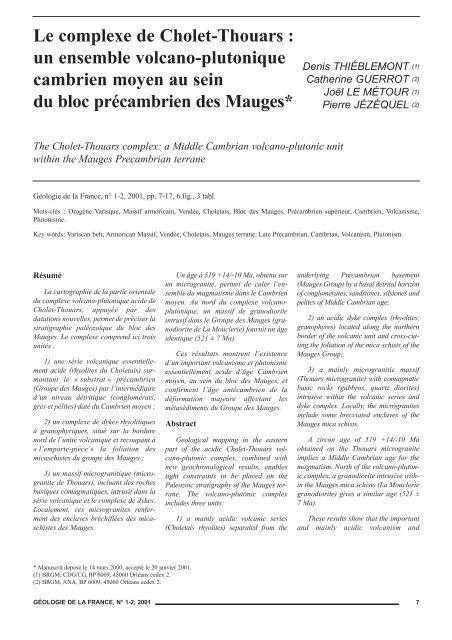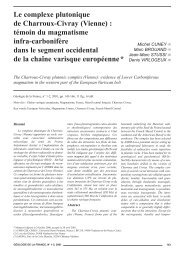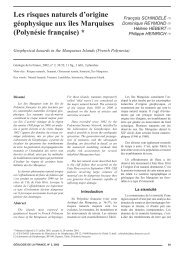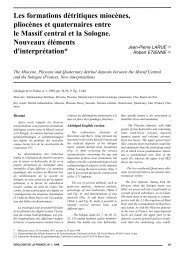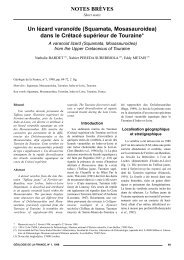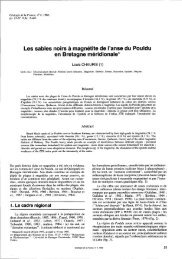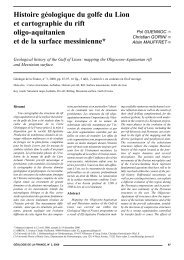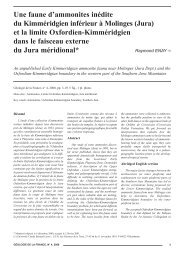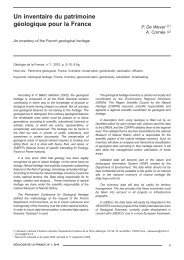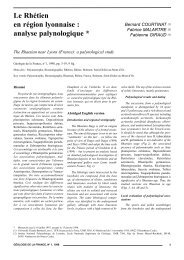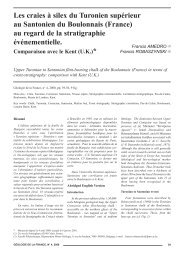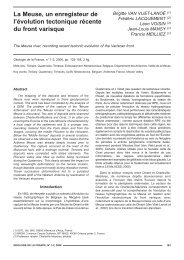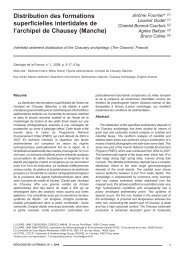Le complexe de Cholet-Thouars : un ensemble volcano-plutonique ...
Le complexe de Cholet-Thouars : un ensemble volcano-plutonique ...
Le complexe de Cholet-Thouars : un ensemble volcano-plutonique ...
You also want an ePaper? Increase the reach of your titles
YUMPU automatically turns print PDFs into web optimized ePapers that Google loves.
<strong>Le</strong> <strong>complexe</strong> <strong>de</strong> <strong>Cholet</strong>-<strong>Thouars</strong> :<br />
<strong>un</strong> <strong>ensemble</strong> <strong>volcano</strong>-<strong>plutonique</strong><br />
cambrien moyen au sein<br />
du bloc précambrien <strong>de</strong>s Mauges*<br />
The <strong>Cholet</strong>-<strong>Thouars</strong> complex: a Middle Cambrian <strong>volcano</strong>-plutonic <strong>un</strong>it<br />
within the Mauges Precambrian terrane<br />
Géologie <strong>de</strong> la France, n° 1-2, 2001, pp. 7-17, 6 fig., 3 tabl.<br />
Résumé<br />
La cartographie <strong>de</strong> la partie orientale<br />
du <strong>complexe</strong> <strong>volcano</strong>-<strong>plutonique</strong> aci<strong>de</strong> <strong>de</strong><br />
<strong>Cholet</strong>-<strong>Thouars</strong>, appuyée par <strong>de</strong>s<br />
datations nouvelles, permet <strong>de</strong> préciser la<br />
stratigraphie paléozoïque du bloc <strong>de</strong>s<br />
Mauges. <strong>Le</strong> <strong>complexe</strong> comprend ici trois<br />
<strong>un</strong>ités :<br />
1) <strong>un</strong>e série volcanique essentiellement<br />
aci<strong>de</strong> (rhyolites du <strong>Cholet</strong>ais) surmontant<br />
le « substrat » précambrien<br />
(Groupe <strong>de</strong>s Mauges) par l’intermédiaire<br />
d’<strong>un</strong> niveau détritique (conglomérats,<br />
grès et pélites) daté du Cambrien moyen ;<br />
2) <strong>un</strong> <strong>complexe</strong> <strong>de</strong> dykes rhyolitiques<br />
à granophyriques, situé sur la bordure<br />
nord <strong>de</strong> l’<strong>un</strong>ité volcanique et recoupant à<br />
« l’emporte-pièce » la foliation <strong>de</strong>s<br />
micaschistes du groupe <strong>de</strong>s Mauges ;<br />
3) <strong>un</strong> massif microgranitique (microgranite<br />
<strong>de</strong> <strong>Thouars</strong>), incluant <strong>de</strong>s roches<br />
basiques comagmatiques, intrusif dans la<br />
série volcanique et le <strong>complexe</strong> <strong>de</strong> dykes.<br />
Localement, ces microgranites renferment<br />
<strong>de</strong>s enclaves bréchifiées <strong>de</strong>s micaschistes<br />
<strong>de</strong>s Mauges.<br />
GÉOLOGIE DE LA FRANCE, N° 1-2, 2001<br />
Un âge à 519 +14/-10 Ma, obtenu sur<br />
<strong>un</strong> microgranite, permet <strong>de</strong> caler l’<strong>ensemble</strong><br />
du magmatisme dans le Cambrien<br />
moyen. Au nord du <strong>complexe</strong> <strong>volcano</strong><strong>plutonique</strong>,<br />
<strong>un</strong> massif <strong>de</strong> granodiorite<br />
intrusif dans le Groupe <strong>de</strong>s Mauges (granodiorite<br />
<strong>de</strong> La Mouclerie) fournit <strong>un</strong> âge<br />
i<strong>de</strong>ntique (521 ± 7 Ma).<br />
Ces résultats montrent l’existence<br />
d’<strong>un</strong> important volcanisme et plutonisme<br />
essentiellement aci<strong>de</strong> d’âge Cambrien<br />
moyen, au sein du bloc <strong>de</strong>s Mauges, et<br />
confirment l’âge antécambrien <strong>de</strong> la<br />
déformation majeure affectant les<br />
métasédiments du Groupe <strong>de</strong>s Mauges.<br />
Abstract<br />
Geological mapping in the eastern<br />
part of the acidic <strong>Cholet</strong>-<strong>Thouars</strong> <strong>volcano</strong>-plutonic<br />
complex, combined with<br />
new geochronological results, enables<br />
tight constraints to be placed on the<br />
Paleozoic stratigraphy of the Mauges terrane.<br />
The <strong>volcano</strong>-plutonic complex<br />
inclu<strong>de</strong>s three <strong>un</strong>its:<br />
1) a mainly acidic volcanic series<br />
(<strong>Cholet</strong>ais rhyolites) separated from the<br />
Denis THIÉBLEMONT (1)<br />
Catherine GUERROT (2)<br />
Joël LE MÉTOUR (1)<br />
Pierre JÉZÉQUEL (2)<br />
Mots-clés : Orogène Varisque, Massif armoricain, Vendée, <strong>Cholet</strong>ais, Bloc <strong>de</strong>s Mauges, Précambrien supérieur, Cambrien, Volcanisme,<br />
Plutonisme.<br />
Key words: Variscan belt, Armorican Massif, Vendée, <strong>Cholet</strong>ais, Mauges terrane, Late Precambrian, Cambrian, Volcanism, Plutonism.<br />
* Manuscrit <strong>de</strong>posé le 14 mars 2000, accepté le 20 janvier 2001.<br />
(1) BRGM, CDG/CG, BP 6009, 45060 Orléans ce<strong>de</strong>x 2.<br />
(2) BRGM, ANA, BP 6009, 45060 Orléans ce<strong>de</strong>x 2.<br />
<strong>un</strong><strong>de</strong>rlying Precambrian basement<br />
(Mauges Group) by a basal <strong>de</strong>trital horizon<br />
of conglomerates, sandstones, silstones and<br />
pelites of Middle Cambrian age;<br />
2) an acidic dyke complex (rhyolites,<br />
granophyres) located along the northern<br />
bor<strong>de</strong>r of the volcanic <strong>un</strong>it and cross-cutting<br />
the foliation of the mica schists of the<br />
Mauges Group;<br />
3) a mainly microgranitic massif<br />
(<strong>Thouars</strong> microgranite) with comagmatic<br />
basic rocks (gabbros, quartz diorites)<br />
intrusive within the volcanic series and<br />
dyke complex. Locally, the microgranites<br />
inclu<strong>de</strong> some brecciated enclaves of the<br />
Mauges mica schists.<br />
A zircon age of 519 +14/-10 Ma<br />
obtained on the <strong>Thouars</strong> microgranite<br />
implies a Middle Cambrian age for the<br />
magmatism. North of the <strong>volcano</strong>-plutonic<br />
complex, a granodiorite intrusive within<br />
the Mauges mica schists (La Mouclerie<br />
granodiorite) gives a similar age (521 ±<br />
7 Ma).<br />
These results show that the important<br />
and mainly acidic volcanism and<br />
7
plutonism of the <strong>Cholet</strong>-<strong>Thouars</strong> region<br />
took place during the Middle Cambrian,<br />
and confirm the pre-Middle Cambrian<br />
age of the main <strong>de</strong>formation event<br />
affecting the Mauges Group.<br />
Abridged English version<br />
Introduction<br />
The <strong>Cholet</strong>-<strong>Thouars</strong> complex is a volcanic<br />
and plutonic complex of ca.<br />
60 x 15 km located in the Mauges<br />
Precambrian block. To the west, it inclu<strong>de</strong>s<br />
a thick and mainly rhyolitic formation<br />
("<strong>Cholet</strong>ais rhyolites") which passes eastward<br />
into a mainly microgranitic <strong>un</strong>it<br />
with subordinate comagmatic gabbros<br />
and diorites ("<strong>Thouars</strong> microgranite")<br />
(<strong>Le</strong>cointre et al., 1948; <strong>Le</strong> Métour and<br />
Bernard-Griffiths, 1979) (Figs. 1-2). The<br />
grouping of the volcanic and plutonic rocks<br />
into a single <strong>volcano</strong>-plutonic complex was<br />
first proposed by Santallier (1964) and further<br />
confirmed by <strong>Le</strong> Métour and Bernard-<br />
Griffiths (1979) and Thiéblemont (1988)<br />
on the basis of field, petrographical, geochemical<br />
and geochronological data.<br />
At the base of the rhyolitic formation<br />
lies a sedimentary <strong>un</strong>it of Middle<br />
Cambrian age (Cavet et al., 1966)<br />
including pelites, siltstones, sandstones<br />
and conglomerates. These sediments<br />
<strong>un</strong>conformably overlie Precambrian<br />
mica schists of the Mauges Group (Cavet<br />
et al., 1966; Wyns and <strong>Le</strong> Métour, 1983;<br />
<strong>Le</strong> Métour et al., 1989). A Late Cambrian<br />
age was initially proposed by <strong>Le</strong>cointre et<br />
al. (1948) and Santallier (1964) for the<br />
whole rhyolitic formation. Later, <strong>Le</strong><br />
Métour and Bernard-Griffiths (1979)<br />
divi<strong>de</strong>d the rhyolites into two <strong>un</strong>its:<br />
1) a lower <strong>un</strong>it of Middle Cambrian<br />
age, and<br />
2) an upper <strong>un</strong>it, comagmatic with the<br />
<strong>Thouars</strong> microgranite. An age of 440 Ma<br />
obtained by the Rb-Sr method on both the<br />
<strong>Thouars</strong> microgranite and associated<br />
rhyolites led <strong>Le</strong> Métour and Bernard-<br />
Griffiths (1979) to propose a Late<br />
Ordovician - Early Silurian age for the<br />
upper volcanic and plutonic <strong>un</strong>it.<br />
The purpose of this note is to present<br />
new field and geochronological data that<br />
precisely <strong>de</strong>fine the age of the <strong>Cholet</strong>-<br />
<strong>Thouars</strong> complex and place additional<br />
constraints on the timing of <strong>de</strong>formation<br />
within the Mauges Group.<br />
8<br />
LE COMPLEXE DE CHOLET-THOUARS DANS LE BLOC PRÉCAMBRIEN DES MAUGES<br />
Field observations<br />
The geological map of Figure 2<br />
summarises the field observations that<br />
led us to reconsi<strong>de</strong>r the stratigraphy of<br />
the Mauges block.<br />
The Mauges Group in the mapped<br />
area is composed mainly of metagreywackes<br />
and mica schists showing a<br />
major S 1 foliation and a subordinate S 2<br />
crenulation cleavage. The S 1 foliation<br />
dips to the south-southwest and its strike<br />
is approximately parallel to the bor<strong>de</strong>r of<br />
the <strong>Cholet</strong>-<strong>Thouars</strong> complex (Fig. 2). The<br />
complex inclu<strong>de</strong>s two main facies - a pink<br />
leuco-microgranite (<strong>Thouars</strong> microgranite)<br />
and a dark subaphyric rhyolite<br />
(<strong>Cholet</strong>ais rhyolites) - and a third transitional<br />
granophyric facies. None of these<br />
rocks show any evi<strong>de</strong>nce of <strong>de</strong>formation.<br />
At various locations (La Boissotière, La<br />
Gran<strong>de</strong> Fondoire, Fig. 2), the microgranite<br />
encloses partially migmatized mica<br />
schists of the Mauges Group and kilometre-size<br />
panels of recrystallized rhyolites.<br />
To the west, the <strong>Cholet</strong>ais rhyolites<br />
show clearly eruptive facies (ignimbrites,<br />
lavas, etc.) in contact with the Middle<br />
Cambrian pelites, sandstones and<br />
conglomerates with a marked southsouthwesterly<br />
dip (~ 50°). North of the<br />
sedimentary rocks, the rhyolitic and<br />
granophyric facies appear as metre- to<br />
<strong>de</strong>cametre-thick dykes cross-cutting the<br />
Mauges Group mica schists. This dyke<br />
complex extends eastward along the<br />
northern limit of the microgranite,<br />
becoming very intense and locally<br />
metamorphosed at the contact with the<br />
microgranite.<br />
To the northeast of the study area, the<br />
metasedimentary rocks of the Mauges<br />
Group are intru<strong>de</strong>d by a granodorite<br />
pluton (La Mouclerie granodiorite). The<br />
granodiorite is nowhere <strong>de</strong>formed, and<br />
differs from the <strong>Thouars</strong> microgranite in<br />
being less leucocratic and coarser<br />
grained.<br />
Geochronology<br />
Sampling and analytical techniques<br />
Two formations were investigated:<br />
1) the <strong>Thouars</strong> microgranite, which<br />
was sampled close to the rhyolites<br />
(Fig. 2), and<br />
2) the La Mouclerie granodiorite. The<br />
petrographic <strong>de</strong>scriptions of the studied<br />
samples are reported in an Annex.<br />
Two analytical techniques were used,<br />
the single-zircon U/Pb technique (dissolution)<br />
and the single-zircon Pb-Pb technique<br />
(evaporation), and gave coherent<br />
results.<br />
<strong>Thouars</strong> microgranite<br />
The <strong>Thouars</strong> microgranite was dated<br />
by the U/Pb technique. The zircons separated<br />
were too few to enable a significant<br />
typological in<strong>de</strong>xation (method of Pupin,<br />
1980).<br />
Six fractions of one to six zircons were<br />
dissolved, of which only one could not be<br />
measured. The crystals are generally<br />
small with common inclusions, and have<br />
low Pb contents, which gives a high common<br />
lead influence leading to high incertitu<strong>de</strong>s.<br />
Despite this problem, the<br />
207 Pb/ 206 Pb ages measured on the five<br />
fractions are homogeneous aro<strong>un</strong>d<br />
520 Ma (Table 1). Only the three most<br />
concordant fractions were retained for the<br />
age <strong>de</strong>termination (Fig. 3), which gave<br />
519 +14/-10 Ma (Fig. 3) that is interpreted<br />
as the age of crystallization of the<br />
<strong>Thouars</strong> microgranite.<br />
La Mouclerie granodiorite<br />
The La Mouclerie granodiorite<br />
provi<strong>de</strong>d ab<strong>un</strong>dant zircons, of which half<br />
could be in<strong>de</strong>xed. In the typological<br />
distribution diagram of Pupin (1980),<br />
these crystals overlap the calc-alkaline<br />
and sub-alkaline fields, suggesting a<br />
mixed crustal and mantle origin for the<br />
original acidic magma (Pupin, 1980).<br />
Both the U/Pb and Pb/Pb techniques<br />
were used for the dating of the La<br />
Mouclerie granodiorite. The three fractions<br />
of five to six zircons selected for the<br />
U/Pb dating plot below the Concordia, and<br />
show 10%, 6% and 74% discordancy<br />
(Fig. 5). The most discordant fraction is<br />
characterized by a high uranium content<br />
and, thereafter, a high lead content. A<br />
Discordia traced from the three fractions<br />
intercepts the Concordia at 521 ± 7 Ma<br />
and 177 Ma, this latter age being consi<strong>de</strong>red<br />
as geologically insignificant. It should<br />
be noted that no evi<strong>de</strong>nce of heritage was<br />
recor<strong>de</strong>d in the analysed fractions.<br />
GÉOLOGIE DE LA FRANCE, N° 1-2, 2001
Ten zircons were analysed by the<br />
Pb/Pb technique, of which only three<br />
could be measured precisely. The age<br />
obtained is 521.1 ± 7.7 Ma, which is perfectely<br />
consistent with the U/Pb result,<br />
and is interpreted as the age of crystallization<br />
of the La Mouclerie granodiorite.<br />
Discussion: stratigraphy<br />
of the <strong>Cholet</strong>-<strong>Thouars</strong> complex and<br />
relationship with the Precambrian<br />
of the Mauges Group<br />
Our results show the existence of two<br />
distinct magmatic <strong>un</strong>its within the<br />
<strong>Cholet</strong>ais rhyolites:<br />
1) a volcanic series, and<br />
2) a dyke complex cross-cutting the<br />
mica schists of the Mauges Group. The<br />
<strong>Thouars</strong> microgranite, dated at 519<br />
+14/-10 Ma, intru<strong>de</strong>s the Precambrian<br />
mica schists, the rhyolitic volcanic series<br />
and the dyke complex.<br />
The difference between the 440 Ma<br />
Rb-Sr age obtained by <strong>Le</strong> Métour and<br />
Bernard-Griffiths (1979) on the <strong>Thouars</strong><br />
microgranite, and the new U/Pb age<br />
suggests that the Rb-Sr system was<br />
remobilized 80 Ma after the original<br />
crystallization of the granitic magma. No<br />
conclusive explanation has yet been<br />
fo<strong>un</strong>d for this remobilization.<br />
The Middle Cambrian age <strong>de</strong>termined<br />
on the sediments located at the<br />
base of the <strong>Cholet</strong>ais rhyolites (Cavet et<br />
al., 1966) and the new age <strong>de</strong>termination<br />
obtained on the <strong>Thouars</strong> microgranite<br />
imply a Middle Cambrian age for the<br />
emplacement of the whole volcanic and<br />
plutonic <strong>Cholet</strong>-<strong>Thouars</strong> complex. This<br />
makes the complex the most important<br />
magmatic <strong>un</strong>it of this age discovered in<br />
France and clearly distinguishes the<br />
Mauges block from neighbouring<br />
Armorican geological domains (Middle<br />
Brittany, Mancellia).<br />
The tholeiitic to alkaline nature of the<br />
<strong>Cholet</strong>-<strong>Thouars</strong> complex has led <strong>Le</strong><br />
Métour and Bernard-Griffiths (1979),<br />
Thiéblemont et al. (1987) and Thiéblemont<br />
(1988) to envisage an emplacement during<br />
an episo<strong>de</strong> of crustal extension. The similar<br />
ages obtained on the tholeiitic <strong>Thouars</strong><br />
microgranite and the calc-alkaline La<br />
Mouclerie granodiorite may indicate some<br />
kind of relationship between the postulated<br />
GÉOLOGIE DE LA FRANCE, N° 1-2, 2001<br />
LE COMPLEXE DE CHOLET-THOUARS DANS LE BLOC PRÉCAMBRIEN DES MAUGES<br />
extensional zone and a process of plate<br />
convergence (back-arc basin setting?).<br />
Finally, our data clearly confirm that<br />
the major tectonic event in the Mauges<br />
block took place prior to the Middle<br />
Cambrian.<br />
Introduction<br />
<strong>Le</strong> <strong>complexe</strong> <strong>de</strong> <strong>Cholet</strong>-<strong>Thouars</strong><br />
affleure au sein du bloc précambrien <strong>de</strong>s<br />
Mauges selon <strong>un</strong>e ban<strong>de</strong> d’environ 60 km<br />
sur 15 km, <strong>de</strong>puis <strong>Cholet</strong> jusqu’à <strong>Thouars</strong>,<br />
où il disparaît sous la couverture jurassique.<br />
Il comprend <strong>un</strong>e puissante <strong>un</strong>ité<br />
éruptive essentiellement rhyolitique à<br />
l’ouest (« Rhyolites du <strong>Cholet</strong>ais »), qui se<br />
prolonge vers l’est en <strong>un</strong> <strong>ensemble</strong> à dominante<br />
microgranitique (« Microgranite <strong>de</strong><br />
<strong>Thouars</strong> ») où se « fon<strong>de</strong>nt » <strong>de</strong>s pointements<br />
dioritiques à gabbroïques comagmatiques<br />
(<strong>Le</strong>cointre et al., 1948 ; <strong>Le</strong><br />
Métour et Bernard-Griffiths, 1979) (fig. 1-<br />
2). <strong>Le</strong> regroupement <strong>de</strong>s <strong>ensemble</strong>s volcanique<br />
et <strong>plutonique</strong> a été initialement<br />
envisagé par Santallier (1964) sur la base<br />
<strong>de</strong> similitu<strong>de</strong>s pétrographiques et confirmé<br />
par les levés cartographiques détaillés et<br />
les investigations géochronologiques et<br />
géochimiques ultérieures (<strong>Le</strong> Métour et<br />
Bernard-Griffiths, 1979 ; Thiéblemont,<br />
1988).<br />
L’<strong>un</strong>ité rhyolitique surmonte les<br />
micaschistes précambriens du Groupe<br />
<strong>de</strong>s Mauges par l’intermédiaire d’<strong>un</strong><br />
niveau détritique fin (pélites et siltites) à<br />
grossier (grès et conglomérats), dont <strong>un</strong><br />
horizon pélitique a été daté du Cambrien<br />
moyen par la découverte <strong>de</strong> Paradoxi<strong>de</strong>s<br />
(Cavet et al., 1966) (fig. 1 et 2). Une discordance<br />
<strong>de</strong> la série cambrienne sur le<br />
Précambrien a été initialement envisagée<br />
(mais « non démontrée ») par Cavet et al.<br />
(1966) et confirmée par Wyns et <strong>Le</strong><br />
Métour (1983) et <strong>Le</strong> Métour et al. (1989).<br />
Ceci implique l’existence d’<strong>un</strong>e tectonique<br />
anté-cambrienne dans le Groupe<br />
<strong>de</strong>s Mauges. Dans cette hypothèse, le<br />
niveau conglomératique est considéré<br />
comme <strong>un</strong> faciès terrigène grossier (poudingue)<br />
marquant la discordance du<br />
Cambrien moyen sur le Précambrien<br />
(Santallier, 1964 ; Cavet et al., 1966 ; <strong>Le</strong><br />
Métour et al., 1989).<br />
Initialement, les rhyolites étaient<br />
considérées comme <strong>un</strong> <strong>ensemble</strong> volcanique<br />
<strong>un</strong>ique rapporté au Cambrien supé-<br />
rieur (<strong>Le</strong>cointre et al., 1948 ; Santallier,<br />
1964). Une division en <strong>de</strong>ux <strong>ensemble</strong>s a<br />
été proposée par <strong>Le</strong> Métour et Bernard-<br />
Griffiths (1979) qui distinguent :<br />
1) <strong>un</strong>e <strong>un</strong>ité inférieure d’âge<br />
cambrien moyen, comprenant les<br />
conglomérats et schistes, ainsi qu’<strong>un</strong>e<br />
première <strong>un</strong>ité rhyolitique ;<br />
2) <strong>un</strong>e <strong>un</strong>ité intermédiaire et supérieure<br />
essentiellement rhyolitique, dont le<br />
sommet serait « comagmatique » du<br />
microgranite <strong>de</strong> <strong>Thouars</strong>. La datation <strong>de</strong><br />
ce microgranite vers 440 Ma (métho<strong>de</strong><br />
Rb-Sr sur roche totale) a conduit <strong>Le</strong><br />
Métour et Bernard-Griffiths (1979) à<br />
attribuer le volcanisme du <strong>Cholet</strong>ais à<br />
<strong>un</strong>e pério<strong>de</strong> s’étendant du Cambrien<br />
moyen à la limite Ordovicien - Silurien.<br />
<strong>Le</strong> but <strong>de</strong> cet article est <strong>de</strong> présenter<br />
<strong>de</strong>s observations et datations nouvelles,<br />
effectuées dans le cadre du levé <strong>de</strong>s<br />
feuilles Montreuil-Bellay (Joubert et al.,<br />
sous presse) et Vihiers (Thiéblemont, en<br />
cours), et qui situent précisément l’âge du<br />
<strong>complexe</strong> <strong>de</strong> <strong>Cholet</strong>-<strong>Thouars</strong> et précisent<br />
ses relations avec le Précambrien du<br />
Groupe <strong>de</strong>s Mauges.<br />
Observations <strong>de</strong> terrain<br />
La carte <strong>de</strong> la figure 2, qui couvre <strong>un</strong>e<br />
partie <strong>de</strong> la terminaison orientale du<br />
<strong>complexe</strong> <strong>de</strong> <strong>Cholet</strong> - <strong>Thouars</strong>, résume<br />
les principales observations qui nous<br />
conduisent à revoir la stratigraphie du<br />
bloc <strong>de</strong>s Mauges.<br />
Dans la région cartographiée, le<br />
Groupe <strong>de</strong>s Mauges est représenté par<br />
<strong>de</strong>s formations métagrauwackeuses à<br />
micaschisteuses (Joubert et al., sous presse).<br />
Plus au nord, s’intercale <strong>un</strong>e <strong>un</strong>ité<br />
métavolcanique basique ou « Formation<br />
<strong>de</strong> Beaupreau », à affinité tholéiitique<br />
(Wyns et <strong>Le</strong> Métour, 1983 ; Cabanis et<br />
Wyns, 1986 ; Wyns et al., 1998). Ces formations<br />
montrent la superposition <strong>de</strong><br />
<strong>de</strong>ux schistosités (S 1 et S 2) (Wyns et <strong>Le</strong><br />
Métour, 1983) ; dans le secteur étudié, la<br />
schistosité majeure (S 1 ) est fortement<br />
pentée vers le SSW, et sa direction apparaît<br />
globalement cohérente avec l’allongement<br />
du <strong>complexe</strong> <strong>volcano</strong>-<strong>plutonique</strong><br />
(WNW) (fig. 2).<br />
Ce <strong>complexe</strong> comprend <strong>de</strong>ux faciès<br />
principaux étroitement associés : <strong>un</strong> faciès<br />
microgranitique rose très leucocrate<br />
9
(microgranite <strong>de</strong> <strong>Thouars</strong>) et <strong>un</strong> faciès<br />
rhyolitique noir, sub-aphyrique (rhyolites<br />
du <strong>Cholet</strong>ais). Un faciès granophyrique<br />
br<strong>un</strong>, parfois sphérolitique, constitue <strong>un</strong><br />
terme <strong>de</strong> transition. Dans le secteur étudié,<br />
ces faciès ne montrent auc<strong>un</strong> indice<br />
<strong>de</strong> déformation pénétrative, les rares<br />
orientations que l’on puisse déceler étant<br />
attribuables aux phénomènes magmatiques.<br />
Ces roches ont fait l’objet <strong>de</strong> nombreuses<br />
<strong>de</strong>scriptions pétrographiques<br />
(<strong>Le</strong>cointre et al., 1948 ; Santallier, 1964 ;<br />
Boyer, 1974 ; Thiéblemont, 1988 ;<br />
Joubert et al., sous presse) que nous ne<br />
reprendrons pas ici.<br />
<strong>Le</strong> faciès microgranitique occupe le<br />
sud-ouest <strong>de</strong> la région d’étu<strong>de</strong>, où il<br />
enclave <strong>de</strong>s gabbros et diorites « comagmatiques<br />
» (<strong>Le</strong> Métour et Bernard-<br />
10<br />
LE COMPLEXE DE CHOLET-THOUARS DANS LE BLOC PRÉCAMBRIEN DES MAUGES<br />
Micaschistes précambriens<br />
<strong>de</strong>s Mauges<br />
Secondaire - Tertiaire<br />
Granitoï<strong>de</strong>s hercyniens<br />
Granite ordovicien <strong>de</strong> Pouzauges<br />
Gabbro <strong>de</strong> Massais<br />
Microgranite <strong>de</strong> <strong>Thouars</strong><br />
Rhyolites du <strong>Cholet</strong>ais<br />
Complexe <strong>de</strong><br />
<strong>Cholet</strong>-<strong>Thouars</strong><br />
Griffiths, 1979) (fig. 2). <strong>Le</strong> microgranite<br />
apparaît également selon <strong>un</strong>e ban<strong>de</strong> <strong>de</strong><br />
largeur kilométrique à plurikilométrique,<br />
localisée au nord, et qui constitue l’extrémité<br />
orientale d’<strong>un</strong> alignement <strong>de</strong> microgranite<br />
et diorite que l’on suit sur toute la<br />
bordure nord du <strong>complexe</strong> <strong>volcano</strong>-<strong>plutonique</strong>,<br />
<strong>de</strong>puis <strong>Thouars</strong> jusqu’au nordouest<br />
<strong>de</strong> Coron (fig. 1). En différents<br />
points (La Boissotière, La Gran<strong>de</strong><br />
Fondoire, fig. 2), le microgranite inclut<br />
<strong>de</strong>s amas bréchiques <strong>de</strong>s micaschistes <strong>de</strong>s<br />
Mauges, largement fondus et/ou injectés<br />
<strong>de</strong> filonnets leucocrates, mais dont les<br />
foliations restent bien reconnaissables.<br />
<strong>Le</strong> faciès rhyolitique affleure largement<br />
dans toute la région étudiée. Vers l’est, il<br />
apparaît en panneaux kilométriques<br />
enclavés dans le microgranite et localement<br />
Granodiorite <strong>de</strong> la Mouclerie<br />
Grès, conglomérat (Cambrien)<br />
Micaschistes<br />
Gneiss et anatexites<br />
10 km<br />
Fig. 1.- Extrait <strong>de</strong> la carte géologique à 1/320 000 <strong>de</strong> Nantes (2ème édition, 1972) et localisation du secteur étudié.<br />
Fig. 1.- Extract from the 1:320,000-scale geological map of Nantes (2nd edition, 1972) showing the location of the study area.<br />
cornéifiés. Vers l’ouest, il montre <strong>de</strong>s termes<br />
franchement effusifs, localement ignimbritiques<br />
(Santallier, 1964 ; Thiéblemont,<br />
1988 ; <strong>Le</strong> Métour et al., 1989). <strong>Le</strong> contact<br />
avec les micaschistes précambriens se fait<br />
par l’intermédiaire <strong>de</strong>s conglomérats à<br />
galets quartzeux pluricentimétriques qui<br />
présentent ici <strong>un</strong> pendage marqué (~ 50°)<br />
vers le SSW (fig. 2). <strong>Le</strong>s galets <strong>de</strong> quartz<br />
sont cimentés par <strong>un</strong> matériau très fin dans<br />
lequel <strong>de</strong>s paillettes <strong>de</strong> séricite soulignent<br />
<strong>un</strong>e schistosité. Adjacents à ces conglomérats,<br />
on trouve les pélites à Paradoxi<strong>de</strong>s<br />
(Cavet et al., 1966) (fig. 2). Au nord <strong>de</strong> cette<br />
ban<strong>de</strong>, <strong>de</strong> nombreux dykes <strong>de</strong> rhyolite et <strong>de</strong><br />
granophyre (et localement <strong>de</strong> dolérite) <strong>de</strong><br />
puissance métrique à décamétrique traversent<br />
les micaschistes du Groupe <strong>de</strong>s<br />
Mauges, recoupant « à l’emporte pièce » la<br />
schistosité S 1 . Vers le sud-est, le réseau filo-<br />
GÉOLOGIE DE LA FRANCE, N° 1-2, 2001
Métasédiments précambriens indifférenciés<br />
du groupe <strong>de</strong>s Mauges<br />
(micaschistes, métagrauwackes et métapélites)<br />
Sédiments fins (grès, pélites) du Cambrien moyen<br />
Conglomérats en barres interstratifées<br />
dans la série cambrienne<br />
GÉOLOGIE DE LA FRANCE, N° 1-2, 2001<br />
LE COMPLEXE DE CHOLET-THOUARS DANS LE BLOC PRÉCAMBRIEN DES MAUGES<br />
Dykes à galets quartzeux intrusifs<br />
dans les micaschistes <strong>de</strong>s Mauges<br />
(secteur du Rueau)<br />
Ensemble volcanique aci<strong>de</strong> du <strong>Cholet</strong>ais<br />
(laves, ignimbrites...)<br />
Complexe <strong>de</strong> dykes rhyolitiques à granophyriques<br />
intrusifs dans les métasédiments briovériens<br />
Microgranite <strong>de</strong> <strong>Thouars</strong><br />
Gabbro<br />
Diorite "hybri<strong>de</strong>"<br />
Zone <strong>de</strong> mélange entre magmas aci<strong>de</strong> et basique<br />
Granodiorite <strong>de</strong> la Mouclerie<br />
<strong>Le</strong> Rueau<br />
Zones cornéifiées<br />
Formations sédimentaires mésozoïques à cénozoïques<br />
Failles<br />
Foliation<br />
Gîte fossilifère<br />
Carrière<br />
Fig. 2.- Carte géologique <strong>de</strong> la partie orientale du <strong>complexe</strong> <strong>volcano</strong>-<strong>plutonique</strong> <strong>de</strong> <strong>Cholet</strong>-<strong>Thouars</strong>, avec indication <strong>de</strong> quelques points d’observations remarquables (dont le gîte fossilifère <strong>de</strong> la vallée du Layon et autres<br />
lieux évoqués dans le texte).<br />
Fig. 2.- Geological map of the eastern part of the <strong>Cholet</strong>-<strong>Thouars</strong> <strong>volcano</strong>-plutonic complex, showing some of the key outcrops.<br />
11
nien <strong>de</strong>vient extrêmement <strong>de</strong>nse et tend à<br />
prédominer sur les micaschistes. <strong>Le</strong> long <strong>de</strong><br />
l’Argenton, <strong>de</strong> bonnes conditions d’affleurement<br />
permettent d’observer <strong>un</strong>e intensification<br />
très nette du système filonien à<br />
l’approche du massif <strong>de</strong> microgranite. Près<br />
<strong>de</strong> sa bordure, les dykes et leur encaissant<br />
métasédimentaire apparaissent cornéifiés,<br />
les <strong>de</strong>ux faciès étant alors très difficiles à<br />
distinguer.<br />
Au sein du système filonien, dans le<br />
secteur du Rueau (fig. 2), nous avons<br />
observé <strong>un</strong> faciès « conglomératique » à<br />
galets quartzeux sous forme d’<strong>un</strong> dyke<br />
métrique recoupant les micaschistes précambriens.<br />
Sous le microscope, les galets<br />
apparaissent séparés par <strong>un</strong> fin ciment<br />
rhyolitique à texture felsitique. Cette roche,<br />
bien que d’aspect macroscopique très<br />
proche <strong>de</strong>s conglomérats sous-jacents à la<br />
série volcanique a <strong>un</strong>e origine clairement<br />
distincte.<br />
Au nord-est du secteur étudié, le<br />
Groupe <strong>de</strong>s Mauges est recoupé par <strong>un</strong><br />
pluton granodioritique (granodiorite <strong>de</strong><br />
La Mouclerie), exempt <strong>de</strong> toute déformation,<br />
et que son grain souvent assez grossier<br />
et sa composition modérément<br />
leucocrate distinguent du microgranite.<br />
Géochronologie<br />
Deux formations ont fait l’objet <strong>de</strong><br />
datations :<br />
1) le microgranite <strong>de</strong> <strong>Thouars</strong>, dont<br />
<strong>un</strong> faciès comm<strong>un</strong> a été échantillonné au<br />
12<br />
LE COMPLEXE DE CHOLET-THOUARS DANS LE BLOC PRÉCAMBRIEN DES MAUGES<br />
Echantillon Concentrations Rapports isotopiques Age<br />
# Min pds. U Pb rad Pb com Pb Pb Pb/U Pb/U Pb Pb<br />
(µg) (ppm) (ppm) (pg) 206/204 208/206 206/238 207/235 207/206 207/206<br />
[1] [2] [3] [4] [4] [4] [4] (Ma)<br />
1 1z 5 108 8.8 21 144 0,41 0.0800 ±8 0.6373 ± 156 0.05779 ± 124 521.9<br />
3 4z 7 329 26.5 60 206 0.37 0.0791 ± 2 0.6300 ± 90 0.05774 ± 50 519.9<br />
4 4z 15 64 5.2 141 51 0.41 0.0777 ± 3 0.6188 ± 200 0.05777 ± 174 521.2<br />
5 5z 6 216 17.9 31 224 0.45 0.0796 ± 2 0.6324 ± 60 0.05765 ± 50 516.5<br />
6 6z 5 256 21.2 30 226 0.44 0.0798 ± 2 0.6359 ± 54 0.05777 ± 44 521.0<br />
Notes :<br />
1 = Minéral : nombre <strong>de</strong> grains z : zircon<br />
2 = Plomb comm<strong>un</strong> total (étalon, contamination et minéral)<br />
3 = corrigé pour la discrimination <strong>de</strong> masse<br />
4 = corrigé pour la discrimination <strong>de</strong> masse, la contamination générale (Pb=15 pg, U=1 pg), l’étalon et le Pb comm<strong>un</strong> initial. <strong>Le</strong>s erreurs sont présentées<br />
à 2σ. La composition isotopique du Pb comm<strong>un</strong> initial a été calculée selon le modèle d'évolution à <strong>de</strong>ux sta<strong>de</strong>s <strong>de</strong> Stacey et Kramers (1975).<br />
Tabl. 1.- Résultats analytiques pour les zircons du microgranite <strong>de</strong> <strong>Thouars</strong> (échantillon DVI31).<br />
Table 1.- Analytical results for the zircons of the <strong>Thouars</strong> microgranite (sample DVI31).<br />
voisinage <strong>de</strong> l’<strong>ensemble</strong> volcanique<br />
aci<strong>de</strong>, dans le secteur <strong>de</strong>s Renaudières<br />
(fig. 2) ;<br />
2) la granodiorite <strong>de</strong> La Mouclerie,<br />
échantillonnée au cœur du massif (fig. 2).<br />
<strong>Le</strong>s <strong>de</strong>scriptions pétrographiques figurent<br />
en annexe 1.<br />
Techniques analytiques<br />
Datation U-Pb sur zircons<br />
Après <strong>un</strong>e séparation classique <strong>de</strong>s<br />
minéraux lourds, les zircons sont séparés<br />
selon leur susceptibilité magnétique, les<br />
moins magnétiques étant le plus souvent<br />
les plus concordants (Krogh, 1982a). Ils<br />
sont ensuite séparés en populations distinctes<br />
s’il y a lieu, et fortement abrasés<br />
afin d’accentuer la concordance (Krogh,<br />
1982b). La mise en solution, la séparation<br />
et la purification <strong>de</strong> l’uranium et du plomb<br />
sont adaptées <strong>de</strong> Krogh (1973) et Parrish<br />
(1987). <strong>Le</strong>s analyses ont été effectuées sur<br />
multiplicateur d’électrons en mo<strong>de</strong> dynamique<br />
sur <strong>un</strong> spectromètre <strong>de</strong> masse<br />
Finnigan MAT 261. <strong>Le</strong>s niveaux <strong>de</strong><br />
contamination sont inférieurs à 15 pg en<br />
Pb et 1 pg en U. <strong>Le</strong>s rapports mesurés sont<br />
corrigés du fractionnement, du blanc <strong>de</strong><br />
procédure, <strong>de</strong> l’étalon, et du plomb comm<strong>un</strong><br />
initial en utilisant le modèle <strong>de</strong><br />
Stacey et Kramers (1975). Toutes les<br />
erreurs sont données à 2σ. La régression<br />
est effectuée selon Davis (1982). Tous les<br />
résultats sont donnés à 95 % <strong>de</strong> niveau <strong>de</strong><br />
confiance.<br />
Datation Pb-Pb par évaporation<br />
sur zircon<br />
Plusieurs cristaux ont été sélectionnés<br />
afin d’être analysés en spectrométrie <strong>de</strong><br />
masse à source soli<strong>de</strong>. La métho<strong>de</strong><br />
d’évaporation directe du plomb sur<br />
monozircon <strong>de</strong> Kober est utilisée. Un<br />
<strong>de</strong>scriptif <strong>de</strong> cette métho<strong>de</strong> se trouve dans<br />
Kober (1986, 1987) et dans Cocherie et<br />
al. (1992). <strong>Le</strong>s erreurs sur les âges par<br />
paliers et âge par zircon sont données à<br />
1σ (écart type). L’âge moyen est calculé<br />
par <strong>un</strong>e moyenne pondérée à partir <strong>de</strong>s<br />
différents paliers conservés, l’erreur sur<br />
l’âge est donnée à 95 % <strong>de</strong> limite <strong>de</strong><br />
confiance, et est calculée par le<br />
programme ISOPLOT/EX, version 2.06d<br />
(Ludwig, 1999).<br />
Microgranite <strong>de</strong> <strong>Thouars</strong><br />
<strong>Le</strong>s zircons <strong>de</strong> cette roche sont petits,<br />
<strong>de</strong> couleur ja<strong>un</strong>e et généralement trapus.<br />
Ils sont trop rares pour permettre <strong>un</strong>e<br />
in<strong>de</strong>xation typologique (métho<strong>de</strong> <strong>de</strong><br />
Pupin, 1980) significative. <strong>Le</strong> microgranite<br />
<strong>de</strong> <strong>Thouars</strong> a été daté par la métho<strong>de</strong><br />
U-Pb par dissolution sur zircons.<br />
Sur les six fractions (<strong>de</strong> 1 à 6 cristaux)<br />
mises en solution, seule la fraction 2 n’a<br />
pu être enregistrée. <strong>Le</strong>s zircons, en général<br />
très petits et contenant <strong>de</strong>s inclusions,<br />
sont caractérisés par <strong>de</strong> faibles teneurs en<br />
Pb. <strong>Le</strong> poids <strong>de</strong>s fractions analysées est en<br />
général faible, ce qui rend l’influence du<br />
plomb <strong>de</strong> contamination plus importante.<br />
GÉOLOGIE DE LA FRANCE, N° 1-2, 2001
En effet, les rapports 206 Pb/ 204 Pb sont<br />
faibles quelle que soit la fraction analysée.<br />
Ils varient <strong>de</strong> 51 à 226. La correction <strong>de</strong><br />
plomb comm<strong>un</strong> est alors très importante<br />
et les résultats sont entachés d’<strong>un</strong>e forte<br />
erreur. <strong>Le</strong>s résultats obtenus sur les cinq<br />
fractions analysées sont reportés dans le<br />
tableau 1. Pour toutes ces fractions, malgré<br />
<strong>de</strong>s corrections importantes, les âges<br />
207 Pb/ 206 Pb sont homogènes autour <strong>de</strong><br />
520 Ma. Pour le calcul d’âge, les fractions<br />
1 et 3 ne sont pas prises en compte, l’erreur<br />
étant trop importante à cause du<br />
plomb comm<strong>un</strong>. <strong>Le</strong>s trois fractions<br />
conservées (fig. 3) sont sub-concordantes<br />
et pratiquement confondues, avec <strong>de</strong>s<br />
âges 207 Pb/ 206 Pb i<strong>de</strong>ntiques, ce qui rend<br />
impossible <strong>un</strong> calcul <strong>de</strong> régression. Il est<br />
nécessaire <strong>de</strong> forcer le passage <strong>de</strong> la<br />
régression (passage forcé à 1 ± 50 Ma).<br />
L’âge ainsi obtenu est <strong>de</strong> 519 +14/-10 Ma<br />
(fig. 3). L’erreur importante reflète l’imprécision<br />
liée aux corrections <strong>de</strong> plomb<br />
comm<strong>un</strong>. Cet âge est interprété comme<br />
l’âge <strong>de</strong> cristallisation du microgranite <strong>de</strong><br />
<strong>Thouars</strong>.<br />
Granodiorite <strong>de</strong> La Mouclerie<br />
<strong>Le</strong>s zircons <strong>de</strong> cette roche sont abondants,<br />
automorphes à arêtes vives et<br />
présentent parfois <strong>de</strong>s zonations concentriques.<br />
Ils sont dissymétriques et <strong>de</strong> couleur<br />
rose pâle. La moitié <strong>de</strong> la population a<br />
pu être in<strong>de</strong>xée. L’indice moyen est A _ .T _ =<br />
572-562, ce qui se situe dans le domaine<br />
calco-alcalin du diagramme typologique<br />
(fig. 4). La population, dans son <strong>ensemble</strong>,<br />
recouvre en partie les domaines calco-alcalin<br />
et sub-alcalin du diagramme (fig. 4),<br />
ceci suggérant <strong>un</strong>e origine hybri<strong>de</strong> (mantellique<br />
et crustale) du magma aci<strong>de</strong><br />
(Pupin, 1980).<br />
Sur cet échantillon, l’analyse géochronologique<br />
a été effectuée à la fois en<br />
dissolution et en évaporation.<br />
En dissolution, trois fractions <strong>de</strong> cinq<br />
à six cristaux les moins magnétiques ont<br />
été analysées (tabl. 2). <strong>Le</strong>s trois fractions<br />
se situent sous la Concordia avec <strong>de</strong>s<br />
<strong>de</strong>grés <strong>de</strong> discordance <strong>de</strong> 10 %, 6 % et<br />
74 % (fig. 5). La fraction 3 est très discordante,<br />
et caractérisée par <strong>un</strong>e teneur en<br />
uranium très élevée, et donc <strong>un</strong>e teneur en<br />
plomb également forte. <strong>Le</strong>s nombreuses<br />
désintégrations subies par le réseau cristallin<br />
ainsi que la présence <strong>de</strong> nombreux<br />
atomes <strong>de</strong> plomb vont altérer la structure<br />
GÉOLOGIE DE LA FRANCE, N° 1-2, 2001<br />
LE COMPLEXE DE CHOLET-THOUARS DANS LE BLOC PRÉCAMBRIEN DES MAUGES<br />
.0854<br />
.0835<br />
.0816<br />
.0797<br />
.0778<br />
.0759<br />
206 Pb<br />
238 U<br />
480<br />
Microgranite <strong>de</strong> <strong>Thouars</strong><br />
Echantillon DVI31<br />
519 +14 Ma<br />
-10<br />
490<br />
235<br />
U<br />
.074<br />
.589 .605 .621 .637 .653 .669 .685<br />
cristalline du zircon et permettre <strong>de</strong>s<br />
pertes <strong>de</strong> plomb importantes se traduisant<br />
par <strong>un</strong>e forte discordance du point analytique.<br />
Néanmoins, les trois points sont<br />
correctement alignés, définissant <strong>un</strong>e<br />
Discordia qui intercepte la Concordia à<br />
521 ± 7 Ma et 177 Ma. L’intercept infé-<br />
500<br />
3<br />
5<br />
6<br />
510<br />
207 Pb<br />
519 Ma<br />
Fig. 3.- Diagramme Concordia U-Pb pour les zircons du microgranite <strong>de</strong> <strong>Thouars</strong> (échantillon DVI31).<br />
<strong>Le</strong>s chiffres correspon<strong>de</strong>nt aux fractions i<strong>de</strong>ntifiées dans le tableau 1.<br />
Fig. 3.- U-Pb Concordia diagram for the zircons of the <strong>Thouars</strong> microgranite (sample DVI31). The<br />
numbers correspond to the fractions i<strong>de</strong>ntified in Table 1.<br />
Fig. 4.- Diagramme <strong>de</strong> répartition typologique <strong>de</strong>s zircons (Pupin, 1980) <strong>de</strong> la granodiorite <strong>de</strong> La<br />
Mouclerie (échantillon DMB123b).<br />
Fig. 4.- Typlogical distribution diagram (Pupin, 1980) for the zircons of the La Mouclerie granodiorite<br />
(sample DMB123b).<br />
rieur n’est pas considéré comme géologiquement<br />
significatif. Auc<strong>un</strong> héritage<br />
ancien n’est mis en évi<strong>de</strong>nce.<br />
Pour la métho<strong>de</strong> Pb-Pb par évaporation,<br />
dix zircons ont été analysés ; quatre<br />
(A, G, I et J) ont donné entre <strong>un</strong> et trois<br />
13
paliers, les autres n’ayant pu être enregistrés.<br />
<strong>Le</strong> zircon A n’a été enregistré que<br />
sur <strong>un</strong> seul bloc à 1420°C, ce qui n’a pas<br />
permis d’obtenir <strong>un</strong> nombre <strong>de</strong> rapports<br />
suffisant. L’âge a donc été calculé d’après<br />
trois zircons, soit cinq paliers <strong>de</strong> température<br />
(fig. 6). <strong>Le</strong> résultat obtenu (521,1<br />
± 7,7 Ma) est parfaitement cohérent avec<br />
le précé<strong>de</strong>nt. Cet âge est interprété<br />
comme l’âge <strong>de</strong> cristallisation <strong>de</strong> la granodiorite<br />
<strong>de</strong> la Mouclerie.<br />
14<br />
LE COMPLEXE DE CHOLET-THOUARS DANS LE BLOC PRÉCAMBRIEN DES MAUGES<br />
Echantillon Concentrations Rapports isotopiques Age<br />
# Min pds. U Pb rad Pb com Pb Pb Pb/U Pb/U Pb Pb<br />
(µg) (ppm) (ppm) (pg) 206/204 208/206 206/238 207/235 207/206 207/206<br />
[1] [2] [3] [4] [4] [4] [4] (Ma)<br />
1 6z 8 534 40.9 6 3211 0.22 0.0788 ± 2 0.6242 ± 28 0.05747 ± 16 509.6<br />
2 5z 11 350 27.6 9 2084 0.23 0.0807 ± 4 0.6416 ± 30 0.05765 ± 20 506.6<br />
3 6z 6 7359 283.7 40 2862 0.01 0.0423 ± 2 0.3138 ± 16 0.05378 ± 8 361.8<br />
Notes :<br />
1 = Minéral : nombre <strong>de</strong> grains z : zircon<br />
2 = Plomb comm<strong>un</strong> total (étalon, contamination et minéral)<br />
3 = corrigé pour la discrimination <strong>de</strong> masse<br />
4 = corrigé pour la discrimination <strong>de</strong> masse, la contamination générale (Pb=15 pg, U=1 pg), l’étalon et le Pb comm<strong>un</strong> initial. <strong>Le</strong>s erreurs sont présentées<br />
à 2σ. La composition isotopique du Pb comm<strong>un</strong> initial a été calculée selon le modèle d'évolution à <strong>de</strong>ux sta<strong>de</strong>s <strong>de</strong> Stacey et Kramers (1975).<br />
Tabl. 2.- Résultats analytiques pour les zircons <strong>de</strong> la granodiorite <strong>de</strong> La Mouclerie (échantillon DMB123b).<br />
Table 2.- Analytical results for the zircons of the La Mouclerie granodiorite (sample DMB123b).<br />
.0891<br />
.0795<br />
.0699<br />
.0603<br />
.0507<br />
.0411<br />
206 Pb<br />
238 U<br />
300<br />
3<br />
Granodiorite <strong>de</strong> la Mouclerie<br />
Echantillon DMB123b<br />
521 ± 7 Ma<br />
350<br />
400<br />
207Pb<br />
235<br />
.0315<br />
U<br />
.279 .352 .425 .498 .571 .644 .717<br />
Fig. 5.- Diagramme Concordia U-Pb pour les zircons <strong>de</strong> la granodiorite <strong>de</strong> La Mouclerie (échantillon<br />
DMB123b). <strong>Le</strong>s chiffres correspon<strong>de</strong>nt aux fractions i<strong>de</strong>ntifiées dans le tableau 2.<br />
Fig. 5.- U-Pb Concordia diagram for the zircons of the La Mouclerie granodiorite (sample DMB123b).<br />
The numbers correspond to the fractions i<strong>de</strong>ntified in Table 2.<br />
450<br />
500<br />
1 2<br />
Discussion : stratigraphie<br />
du <strong>complexe</strong> <strong>de</strong> <strong>Cholet</strong> -<br />
<strong>Thouars</strong> et relation avec le<br />
Précambrien <strong>de</strong>s Mauges<br />
<strong>Le</strong>s résultats présentés dans cette note<br />
précisent la structure <strong>de</strong> la partie orientale<br />
du <strong>complexe</strong> <strong>volcano</strong>-<strong>plutonique</strong> <strong>de</strong> <strong>Cholet</strong><br />
- <strong>Thouars</strong>. Deux entités sont distinguées au<br />
sein <strong>de</strong> l’<strong>ensemble</strong> rhyolitique (rhyolites du<br />
<strong>Cholet</strong>ais) :<br />
1) <strong>un</strong>e série volcanique ;<br />
2) <strong>un</strong> <strong>complexe</strong> <strong>de</strong> dykes rhyolitiques à<br />
granophyriques recoupant à « l’emportepièce<br />
» la foliation <strong>de</strong>s micaschistes précambriens.<br />
<strong>Le</strong> microgranite <strong>de</strong> <strong>Thouars</strong>,<br />
daté à 519 +14/-10 Ma, est intrusif dans la<br />
série volcanique et le <strong>complexe</strong> <strong>de</strong> dykes,<br />
et renferme localement <strong>de</strong>s enclaves <strong>de</strong>s<br />
micaschistes précambriens.<br />
Ce microgranite, ainsi que <strong>de</strong>s rhyolites<br />
qui lui sont associées, ont été précé<strong>de</strong>mment<br />
datés vers 440 Ma par la métho<strong>de</strong><br />
Rb-Sr sur roche totale (<strong>Le</strong> Métour et<br />
Bernard-Griffiths, 1979). Ce résultat apparaît<br />
incompatible avec notre nouvelle datation,<br />
qui indique <strong>un</strong> âge <strong>de</strong> cristallisation<br />
cambrien moyen pour le magma aci<strong>de</strong>. On<br />
doit donc conclure que la datation précé<strong>de</strong>nte<br />
témoigne d’<strong>un</strong> « raje<strong>un</strong>issement » du<br />
système Rb-Sr. <strong>Le</strong> Métour et Bernard-<br />
Griffiths (1979) notent qu’<strong>un</strong> tel phénomène<br />
peut résulter <strong>de</strong> la dévitrification <strong>de</strong>s<br />
verres volcaniques et/ou du passage <strong>de</strong>s<br />
feldspaths <strong>de</strong> formes <strong>de</strong> haute température<br />
vers <strong>de</strong>s formes <strong>de</strong> basse température.<br />
L’excellente définition <strong>de</strong>s isochrones<br />
obtenues sur les microgranites et rhyolites<br />
implique <strong>un</strong>e « réhomogénéisation » totale<br />
du système Rb-Sr vers la limite Ordovicien<br />
- Silurien. Auc<strong>un</strong> phénomène magmatique<br />
ou hydrothermal <strong>de</strong> cet âge n’est connu au<br />
sein du bloc <strong>de</strong>s Mauges aussi, le problème<br />
reste-t-il entier.<br />
La présence <strong>de</strong> Paradoxi<strong>de</strong>s à la base<br />
<strong>de</strong> la série volcanique (Cavet et al., 1966)<br />
et la datation nouvelle obtenue sur le<br />
microgranite situent la mise en place du<br />
<strong>complexe</strong> <strong>volcano</strong>-<strong>plutonique</strong> <strong>de</strong> <strong>Cholet</strong> -<br />
<strong>Thouars</strong> au Cambrien moyen, ce qui en fait<br />
GÉOLOGIE DE LA FRANCE, N° 1-2, 2001
le plus volumineux témoin d’<strong>un</strong> magmatisme<br />
<strong>de</strong> cet âge connu en France. Cet<br />
<strong>ensemble</strong>, <strong>de</strong> nature tholéiitique à alcaline,<br />
est rapporté à <strong>un</strong> épiso<strong>de</strong> <strong>de</strong> distension<br />
crustale ayant affecté le bloc <strong>de</strong>s Mauges<br />
(<strong>Le</strong> Métour et Bernard-Griffiths, 1979 ;<br />
Thiéblemont et al., 1987 ; Thiéblemont,<br />
1988). L’âge obtenu sur la granodiorite <strong>de</strong><br />
La Mouclerie (521 ± 7 Ma), i<strong>de</strong>ntique à<br />
celui du microgranite <strong>de</strong> <strong>Thouars</strong>, confirme<br />
l’existence d’<strong>un</strong> plutonisme cambrien<br />
moyen dans le bloc <strong>de</strong>s Mauges et y suggère<br />
la possibilité d’<strong>un</strong>e signature calco-alcaline<br />
discrète. Cette signature peut suggérer<br />
<strong>un</strong>e relation entre la distension et <strong>un</strong> phénomène<br />
<strong>de</strong> convergence <strong>de</strong> plaque (contexte<br />
<strong>de</strong> bassin arrière-arc ?).<br />
L’importance <strong>de</strong> ce magmatisme cambrien<br />
distingue clairement le bloc <strong>de</strong>s<br />
Mauges du domaine centre-armoricain,<br />
dans lequel les premières manifestations<br />
volcaniques postérieures au Briovérien<br />
sont datées <strong>de</strong> l’Arénigien (Bonjour et<br />
Odin, 1989). De même, si <strong>un</strong> volcanisme<br />
essentiellement aci<strong>de</strong>, s’échelonnant du<br />
Cambrien inférieur aux temps pré-arénigiens<br />
(<strong>Le</strong> Gall et Cabanis, 1985), est<br />
connu en Normandie, cette région se distingue<br />
clairement du bloc <strong>de</strong>s Mauges par<br />
la présence d’<strong>un</strong> important <strong>complexe</strong> <strong>de</strong><br />
granodiorites peralumineuses (Batholite<br />
mancellien), mises en place à l’issue <strong>de</strong><br />
l’orogenèse cadomienne (~ 540 Ma) et<br />
intrusives dans le Briovérien.<br />
Enfin, outre les précisions sur l’âge et la<br />
stratigraphie du magmatisme, nos résultats<br />
confirment l’âge anté-cambrien <strong>de</strong> la déformation<br />
majeure dans le Groupe <strong>de</strong>s Mauges<br />
(Cavet et al., 1966 ; Wyns et <strong>Le</strong> Métour,<br />
1983 ; <strong>Le</strong> Métour et al., 1989). <strong>Le</strong>s arguments<br />
les plus évi<strong>de</strong>nts sont les suivants :<br />
1) superposition totale du <strong>complexe</strong><br />
<strong>de</strong> dykes rhyolitiques sur les structures<br />
<strong>de</strong>s micaschistes <strong>de</strong>s Mauges ;<br />
2) bréchification <strong>de</strong> ces micaschistes<br />
dans les microgranites ;<br />
3) cornéification « fossilisant » les<br />
structures <strong>de</strong>s micaschistes en bordure du<br />
microgranite.<br />
GÉOLOGIE DE LA FRANCE, N° 1-2, 2001<br />
LE COMPLEXE DE CHOLET-THOUARS DANS LE BLOC PRÉCAMBRIEN DES MAUGES<br />
Zircon T(°)<br />
palier<br />
Nbre<br />
rappor<br />
ts<br />
206 Pb<br />
204 Pb<br />
208 Pb<br />
206 Pb<br />
207 Pb*/ 20 6Pb*<br />
± 1σ<br />
Age par<br />
palier<br />
± 1σ<br />
Zr A 1420 5 16690 0.063 0.05748 ± 44 510 ± 17<br />
Zr G 1420 29 6550 0.106 0.05784 ± 32 524 ± 12<br />
Age par<br />
Zircon<br />
± 1σ<br />
1440 27 41210 0.091 0.05764 ± 25 516 ± 9 520 ± 11<br />
Age moyen<br />
(Ma)<br />
± 2σ<br />
Zr I 1420 62 83160 0.083 0.05787 ± 15 525 ± 6 525 ± 6 377 ± Ma<br />
Zr J 1420 15 14610 0.094 0.05759 ± 73 514 ± 27 MSWD = 0.28<br />
1440 53 17080 0.132 0.05773 ± 32 520 ± 12<br />
1640 69 70490 0.143 0.05761 ± 27 515 ± 10 517 ± 11<br />
Tabl. 3.- Données analytiques obtenues par évaporation du plomb sur monozircon pour la granodiorite<br />
<strong>de</strong> la Mouclerie (échantillon DMB123b). <strong>Le</strong>s erreurs sur les âges par palier et par zircon sont données à<br />
1σ (écart-type). L’âge moyen est la moyenne pondérée <strong>de</strong>s différents paliers conservés (en gras) et est<br />
donné à ± 2σ (95 % limite <strong>de</strong> confiance).<br />
Table 3.- Analytical results obtained by the single-zircon Pb evaporation technique for the La Mouclerie<br />
granodiorite (sample DMB123b). The errors on the ages for each temperature step and each zircon are<br />
given to 1σ (standard <strong>de</strong>viation). The mean age is the weighted average of the ages obtained at the<br />
different temperature steps (bold characters) and is given to ± 2σ (95% confi<strong>de</strong>nce limit).<br />
550<br />
540<br />
530<br />
520<br />
510<br />
500<br />
490<br />
480<br />
470<br />
Granodiorite <strong>de</strong> La Mouclerie<br />
Age moyen = 521.1 ± 7.7 [1.5% ] 95% conf.<br />
MSWD = 0.30, probabilité = 0.88<br />
(barres d’erreur à 2σ)<br />
Fig. 6.- Diagramme palier <strong>de</strong> température vs. âge 207Pb/ 206Pb pour les zircons <strong>de</strong> la granodiorite <strong>de</strong> La<br />
Mouclerie (échantillon DMB123b).<br />
Fig. 6.- Temperature step vs. 207Pb/ 206Pb age for the zircons of the La Mouclerie granodiorite (sample<br />
DMB123b).<br />
Références<br />
Bonjour J.L., Odin G.S. (1989) - Recherche sur les <strong>volcano</strong>clastites <strong>de</strong>s Séries Rouges Initiales en presqu’île <strong>de</strong> Crozon : premier âge radiométrique <strong>de</strong> l’Arénig.<br />
Géologie <strong>de</strong> la France, n° 4, 3-8.<br />
Boyer C. (1974) - Volcanismes aci<strong>de</strong>s paléozoïques dans le Massif Armoricain. Thèse d’Etat, Orsay, 384 p.<br />
Cabanis B., Wyns R. (1986) - <strong>Le</strong> volcanisme précambrien <strong>de</strong>s Mauges (sud-est du Massif armoricain) et ses caractères géochimiques. Hercynica, Rennes, (II),<br />
1, 71-78.<br />
15
LE COMPLEXE DE CHOLET-THOUARS DANS LE BLOC PRÉCAMBRIEN DES MAUGES<br />
Cavet P., Gruet M., Pillet J. (1966) - Sur la présence <strong>de</strong> Cambrien à paradoxi<strong>de</strong>s à Cléré-sur-Layon (Maine-et-Loire), dans le Nord-Est du Bocage vendéen<br />
(Massif armoricain). C.R. Acad. Sci., Fr., Paris, 263, (D), 1685-1688.<br />
Cocherie A., Guerrot C., Rossi P. (1992) - Single-zircon dating by step-wise Pb evaporation: Comparison with other geochronological techniques applied to<br />
the Hercynian granites of Corsica, France. Chem. Geol., 101, 131-141.<br />
Davis D.W. (1982) - Optimum linear regression and error estimation applied to U-Pb data. Can. J. Earth Sci., 19, 2141-2149.<br />
Joubert J.M., Thiéblemont D., Karnay G., Wyns R. (sous presse) - Carte géologique <strong>de</strong> Montreuil-Bellay et notice explicative. Editions du BRGM.<br />
Kober B. (1986) - Whole grain evaporation for 207Pb/206Pb- age - investigation on single zircons using a double filament thermal ion source. Contrib. Mineral.<br />
Petrol., 93, 482-490.<br />
Kober B. (1987) - Single-zircon evaporation combined with Pb+ emitter bedding for 207Pb/206Pb-age investigations using thermal ion mass spectrometry and<br />
implications for zirconology. Contrib. Mineral. Petrol., 96, 63-71.<br />
Krogh T.E. (1973) - A low-contamination method for hydrothermal <strong>de</strong>composition of zircon and extraction of U and Pb for isotopic age <strong>de</strong>termination.<br />
Geochim. Cosmochim. Acta, 37, 485-494.<br />
Krogh T.E. (1982a) - Improved accuracy of U-Pb zircon dating by selection of more concordant fractions using a high gradient magnetic separation technique.<br />
Geochim. Cosmochim. Acta, 46, 631-635.<br />
Krogh T.E. (1982b) - Improved accuracy of U-Pb zircon ages by the creation of more concordant systems using an air abrasion technique. Geochim.<br />
Cosmochim. Acta, 46, 637-649.<br />
<strong>Le</strong> Gall J., Cabanis B. (1985) - Caractères minéralogiques et géochimiques <strong>de</strong>s ignimbrites et <strong>de</strong>s laves cambriennes <strong>de</strong> l’Est du Massif armoricain. Implications<br />
pétrogénétiques. Hercynica, I, 2, 99-109.<br />
<strong>Le</strong> Metour J., Bernard-Griffiths J. (1979) - Age (limite Ordovicien - Silurien) <strong>de</strong> mise en place du massif hypovolcanique <strong>de</strong> <strong>Thouars</strong> (Massif Vendéen).<br />
Implications géologiques. Bull. BRGM, Fr. (2), I, 4,.365-371.<br />
<strong>Le</strong> Metour J., avec la collaboration <strong>de</strong> Blouin J.P., Chantraine J., Clozier L., Etienne H. (1989) - Notice explicative, Carte géologique <strong>de</strong> la France (1/50 000),<br />
feuille <strong>Cholet</strong> (510). BRGM, Orléans, 55 p. Carte géologique par Clozier L. et <strong>Le</strong> Metour J. (1984).<br />
<strong>Le</strong>cointre G., Mathieu G., Waterlot G. (1948) - Carte géologique détaillée à 1/80 000, feuille Saumur, 2ème Edition.<br />
Ludwig K.R. (1999) - Isoplot/Ex version 2.06 : A Geochronological Toolkit for Microsoft Excel. Berkeley Geochronology Center, Special Publication N° 1a. 49 p.<br />
Parrish R.R. (1987) - An improved micro-capsule for zircon dissolution in U-Pb geochronology. Chem. Geol. (Isotop. Geosc. Sect.), 66, 99-102.<br />
Pupin J.P. (1980) - Zircon and granite petrology. Contrib. Mineral. Petrol., 73, 207-220.<br />
Santallier D. (1964) - Etu<strong>de</strong> <strong>de</strong>s roches granitiques et <strong>de</strong>s laves paléozoïques du <strong>Cholet</strong>ais. Thèse 3ème cycle, Paris, 117 p.<br />
Stacey J.S., Kramers J.D. (1975) - Approximation of terrestrial lead isotope evolution by a two stage mo<strong>de</strong>l. Earth Planet. Sci. <strong>Le</strong>tt., 26, 207-221.<br />
Thiéblemont D. (1988) - <strong>Le</strong> magmatisme paléozoïque en Vendée. Apport <strong>de</strong> la géochimie <strong>de</strong>s éléments traces et <strong>de</strong> la pétrologie du métamorphisme à la<br />
compréhension du développement orogénique varisque. Document du BRGM, Orléans, n° 157, 365 p.<br />
Thieblemont D., Cabanis B., <strong>Le</strong> Metour J. (1987) - Etu<strong>de</strong> géochimique d’<strong>un</strong> magmatisme <strong>de</strong> distension intracontinentale : la série bimodale ordovico-silurienne<br />
du <strong>Cholet</strong>ais (Massif Vendéen). Géologie <strong>de</strong> la France, 1, 65-76.<br />
Wyns R., <strong>Le</strong> Métour J. (1983) - <strong>Le</strong> Précambrien du massif vendéen. Etu<strong>de</strong> détaillée <strong>de</strong> <strong>de</strong>ux coupes <strong>de</strong> référence (coupes <strong>de</strong> l’Evre et <strong>de</strong> la Divatte) et synthèse<br />
<strong>de</strong>s données récentes. Document du BRGM, Orléans, 68, 60 p.<br />
Wyns R., Lar<strong>de</strong>ux H., Mogue<strong>de</strong>t G., Duermael G., Gruet M., Biagi R. avec la collaboration <strong>de</strong> Ballevre M., Chevremont P. (1998) - Notice explicative, carte<br />
géologique <strong>de</strong> la France (1/50 000), feuille Chemillé (483). BRGM, Orléans, 72 p. Carte géologique par Wyns R., Clement J.P., Lar<strong>de</strong>ux H., Gruet M.,<br />
Mogue<strong>de</strong>t G., Biagi R. et Ballevre M. (1998).<br />
16<br />
GÉOLOGIE DE LA FRANCE, N° 1-2, 2001
Echantillon DMB123b<br />
Granodiorite <strong>de</strong> la Mouclerie<br />
GÉOLOGIE DE LA FRANCE, N° 1-2, 2001<br />
LE COMPLEXE DE CHOLET-THOUARS DANS LE BLOC PRÉCAMBRIEN DES MAUGES<br />
Microgranodiorite à biotite et rare amphibole<br />
Annexe 1<br />
Description pétrographique <strong>de</strong>s échantillons datés<br />
Texture microgrenue équante avec biotite assez abondante en phénocristaux automorphes frais, souvent groupés (ils peuvent<br />
alors évoquer <strong>de</strong>s enclaves) et à fréquentes inclusions d’opaques.<br />
Petits paquets d’amphibole fibreuse peu colorée (actinote ??).<br />
Plagioclase abondant, automorphe, souvent zoné.<br />
Quartz en assez gros cristaux interstitiels.<br />
Feldspath potassique assez abondant, mais en position interstitielle associé au quartz.<br />
Altération limitée : séricite dans plagioclase et chloritisation très locale <strong>de</strong> la biotite.<br />
Accessoires : zircon, apatite.<br />
Echantillon DVI31<br />
Microgranite <strong>de</strong> <strong>Thouars</strong>.<br />
Microgranite partiellement recristallisé, à nombreux « bourgeons » myrmékitiques.<br />
Texture microgrenue équante à granophyrique.<br />
Plagioclase abondant, en phénocristaux automorphes saussuritisés. Taille millimétrique à plurimillimétrique (5 mm pour<br />
certains individus allongés).<br />
Quartz abondant en cristaux limpi<strong>de</strong>s sub-millimétriques.<br />
Feldspath potassique abondant, en plages polycristallines regroupant <strong>de</strong>s individus inframillimétriques adjacentes aux quartz et<br />
plagioclase.<br />
« Bourgeons myrmékitiques » abondants (~ 20% du volume) en position interstitielle.<br />
Chlorite assez fréquente, interstitielle, en partie développée au détriment <strong>de</strong> la biotite.<br />
Epidote assez fréquente, en grains dans plagioclase (saussuritisation) ou dans le fond <strong>de</strong> la roche associée à la chlorite.<br />
Accessoires : opaques (pro-parte hématite) localement assez abondants (avec chlorite) et altérés. Zircons rares et <strong>de</strong> petite taille.<br />
17
18<br />
LE LITTORAL<br />
Problèmes et pratiques <strong>de</strong> l’aménagement<br />
sous la direction <strong>de</strong> B. Gérard<br />
Manuels et Métho<strong>de</strong>s n° 32, 1 vol., 352 p. (1999)<br />
Quel est l’apport <strong>de</strong>s scientifiques aux processus <strong>de</strong> décision à propos d’aménagement du littoral et <strong>de</strong> quelles<br />
informations les déci<strong>de</strong>urs doivent-ils disposer pour permettre <strong>un</strong> développement économique respectueux <strong>de</strong><br />
l’environnement ? Telles sont les questions étudiées dans cet ouvrage qui montre avant tout qu’<strong>un</strong>e approche<br />
globale <strong>de</strong>s problèmes doit être envisagée et que la pertinence <strong>de</strong>s solutions dépendra, d’<strong>un</strong>e part, <strong>de</strong> la<br />
mobilisation simultanée <strong>de</strong>s différents acteurs : scientifiques, déci<strong>de</strong>urs, usagers et, d’autre part, <strong>de</strong> leur capacité<br />
à dialoguer. Rédigé par <strong>un</strong> collectif <strong>de</strong> 23 auteurs, spécialistes du domaine, il privilégie l’approche<br />
pluridisciplinaire.<br />
What is the scientist’s role in the <strong>de</strong>cision-making processes relative to coastal <strong>de</strong>velopment and what data is<br />
required by the <strong>de</strong>cision makers to ensure economic <strong>de</strong>velopment in harmony with the environment? These and<br />
other questions are tackled in this manual, which shows above all that a global approach to the problems must<br />
be adopted and that the aptness of the solutions <strong>de</strong>pends both on the simultaneous involvement of the different<br />
parties (scientists, <strong>de</strong>cision makers and users) and on their abilities to comm<strong>un</strong>icate. With contributions from<br />
23 authors specialized in this domain, it favours the multidisciplinary approach.<br />
Prix <strong>de</strong> vente : 350 F + 50 F <strong>de</strong> frais <strong>de</strong> port et d’emballage pour la France et 60 F pour l’Étranger.<br />
En vente chez votre libraire habituel ou aux : Éditions BRGM - BP 6009 - 45060 Orléans Ce<strong>de</strong>x 2 - France - Tél. : 02 38 64 30 28.<br />
Fax : 02 38 64 36 82 accompagné <strong>de</strong> votre titre <strong>de</strong> paiement.<br />
GÉOLOGIE DE LA FRANCE, N° 1-2, 2001


